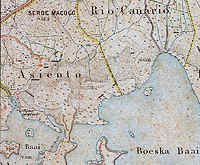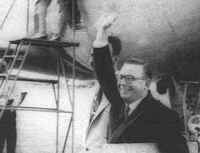
Politics


Curaçao escutcheon
with in center, still
Amsterdam escutcheon
Colonial History
Curaçao was discovered in 1499 by Alonso de Ojeda. It was owned by Spain until 1634, when it was taken over by the Netherlands. With some interludes, until 1954 the islands remained a Dutch possession as the Colony of Curaçao.
The Spaniards didn't care much for Curaçao, calling it one of the islas inutiles [useless islands]. They did take as good as all Curaçao Caiquetío Indians to Hispañola (Santo Domingo) to work there. Even before the event, the Indians didn't care much for the Spaniards. Later, Curaçao was privately owned by Juan de Ampués and his heirs; they left the Indians pretty much alone and some families were even allowed to return from Hispañola. There was no slavery here - yet.
The Dutch Are Coming!
The Dutch had several good things going at the time, like selling pickled herring all over Europe and trading in Indonesian spices. For that, they were dependant on salt, which they got from Portugal and Spain. But after they started their Eighty Years War with Spain, they had to look farther for that commodity and their beady eye fell on Curaçao and Bonaire. Their West-Indische Compagnie in 1634 conquered the islands from the Spaniards, who never even tried to get them back.
This West India Company was a gigantic concern, starting with a capital of seven million guilders - this was 1621. Except Curaçao, Aruba and Bonaire it held Nieuw Nederland (Manhattan), Essequibo (British Guyana) and a large part of the Brazil coast, with the Dutch monopoly for all trade in these parts. This included salt, slavery and privateering. W.I.C., like her counterpart V.O.C. in Oost-Indië [Indonesia], was absolute ruler in these parts. Only in 1792 the Dutch Republic government took over.

Besides salt, privateering was maybe even better business! There is a street in Willemstad named after Erasmus, but not after Desiderius the humanist, don't be so naïve - after Jan the privateer. A very good reason for the Dutch to hang on to Curaçao was the harbor, which could be put to good use for all sorts of profitable purposes. Even if it was downwind, far from ideal, it was a much better harbor than for example Kingston, Jamaica. As a matter of fact, it was such a success that in 1666 the English tried to abate the nuisance by sending a fleet of Navy ships with privateers. But they quarreled on their way down and split up. The Dutchman Piet Heijn, about whom Dutch children still sing a song in kindergarten, was so notorious that when the Spanish silver fleet saw him approaching on the horizon, they went to ground on the Cuban coast and left their ships to flee to the coast in panic.
But there was no sounder trade than slavery. The Portuguese took the first African slaves to Brazil in 1503, but Spanish emperor Charles V soon took over and started selling asientos, agreements with the state to deliver a number of slaves; the first Dutchman got one for the West Indies in 1516, more than a century before Curaçao was taken over by W.I.C. The Eighty Year War ended in 1648, and by 1685 W.I.C. had signed so many asientos that they were the biggest slave traders in the world. In 1668 there were 3000 slaves in the Curaçao asiento, which place name is still in use.

The Werbata Maps
This hardly is the place to go into a discussion of slavery, but without having any inclination to defend the practice we have to remark that it was not in anybody's interest to have their cargo die on the way over (or after), so conditions aboard slave-traders can't have been all bad. The expected loss of 15% on a trip was, in those days, not much worse than the loss among the crew. Actually, it's pretty good, considering, so it's not very surprising this, in practice, often was 20 to 25%. If you want to describe the members of the crew as little, if any, better off than their cargo, you have a very good point.Competition
The French came by and conquered several times, and so did the English and the Spanish. This was quite usual in the Caribbean anyway in those times; business mostly went on as usual. Running guns was doing fine when America had started the revolution. However, the fact that St. Eustatius was the first in the world to officially salute the American flag with 11 gun shots was too much for the English to swallow and their Admiral Romney looted
Statia, St. Martin and Saba - only to have their ships taken by the French on the way to England. By 1792 W.I.C. was bankrupt. The French tried again in 1800, to
protectCuraçao from the English, and succeeded. The English, while at war with the Bataafsche Republiek of the Netherlands, kicked the French out and gave the Antilles back to Holland in 1803; to come back in 1804 with a blockade. And so it went on until 1816, when after the time of Napoléon the Netherlands became an autonomous European kingdom again.
Bad Business
By then, of course, the English nation singlehandedly had stopped the slave trade by policing the seas and business was kaput. Finally, the Antillean slaves were emancipated by the Good King of Holland, in 1863. From then on, they were graciously allowed to eke out their own living without owners being responsible; they couldn't afford it any more, so this may have been seen as a nice, clean and humane solution. Even so, it took an awful lot of prodding by catholic bishop Nieuwindt. One of the end results of slavery is that, like in most of the Caribbean, some 90% of the Curaçao population has African origins.
The six Dutch Caribbean islands remained part of the Colony of Curaçao until well after World War II. They were poor. Virtually the only thing Curaçao island had going was the harbor and the resulting commerce. Business picked up a bit with the opening of the Panama Canal and the advent of steam ships, when Willemstad harbor saw new use as a bunkering station. When Royal Dutch opened the C.P.I.M. Isla refinery on Curaçao and Standard Oil the Lago on Aruba to process oil from the Venezuela Maracaïbo Lake, business started booming. Especially during the second World War, always good for business, there was an enormous population explosion.
With the general anti-colonialism feelings throughout the world and the bitter experience of the Indonesian disaster, the Netherlands was forced to let the colonies go. This happened in 1954, when what remained of the former Rijksdeelen Overzee (except New Guinea) and Holland in Europe signed the Koninkrijksstatuut, which made them autonomous countries united in the Kingdom of the Netherlands: Holland, Suriname and the Nederlandse Antillen.

Colony-Country
After the 2005 Referendum
Sold and Betrayed
SEARCH this site or the Web

copyright notice
all material on this site, except where noted
copyright © by , curaçao
reproduction in any form for any purpose is prohibited
without prior consent in writing